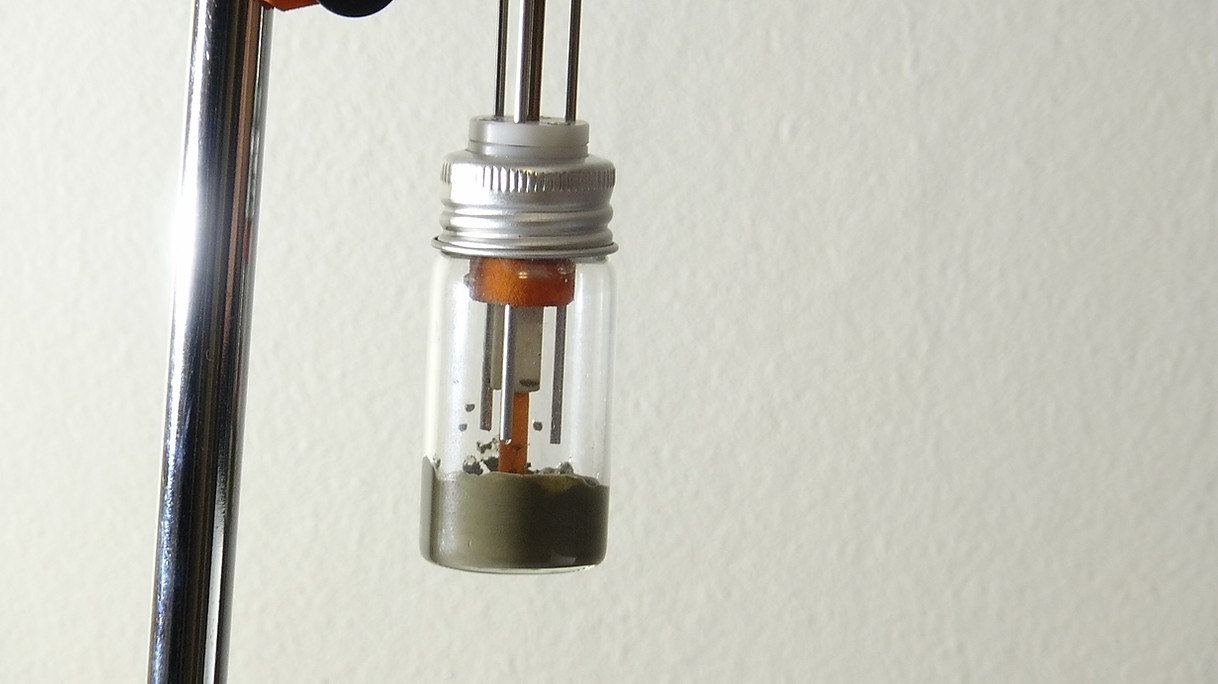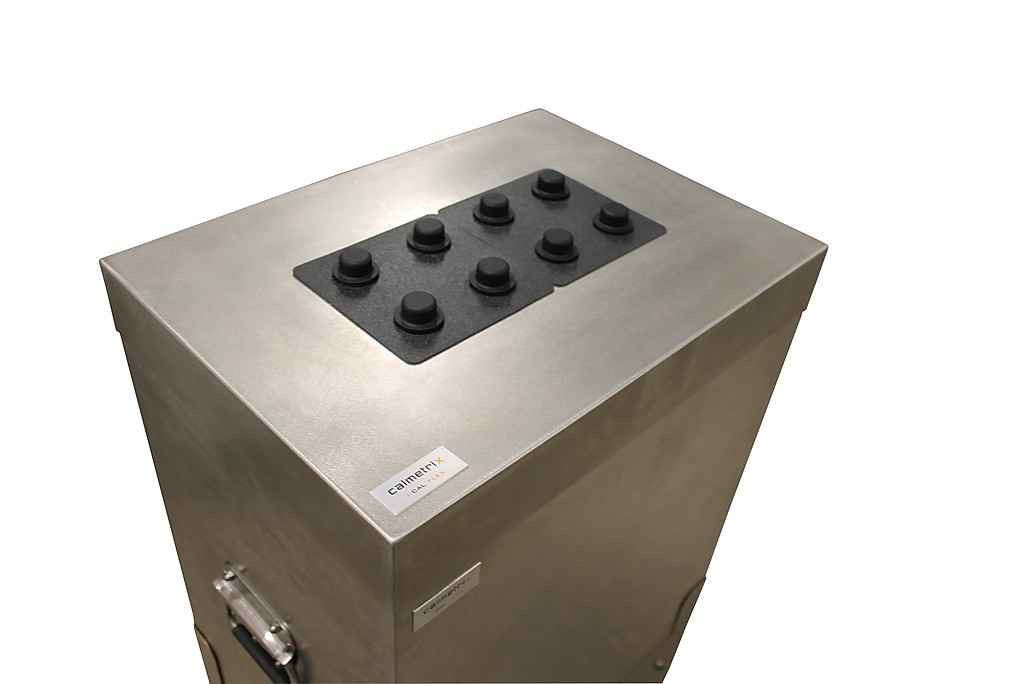I-Cal Ultra는 1-8 개의 샘플 셀을 수용할 수 있으며, 시멘트 및 다양한 시멘트질 또는 포졸란 물질 분야에서 소량의 샘플을 테스트하도록 설계되었습니다. I-Cal Ultra는 뛰어난 감도와 정밀함, 온도 제어능력을 갖추고 있습니다. ASTM C1679 및 ASTM C1702, ASTM C563, EN 196-11 표준을 완벽하게 따르며, 본 모델의 성능에 더불어 최대 몇 개월의 장기적인 테스트를 포함하여 훨씬 더 고급적인 연구가 가능합니다. I-Cal Ultra는 레퍼런스를 사용하여 최대 8 채널까지 1 채널 20ml의 샘플을 측정하는 고급 등온열량계입니다. 높은 수준의 정밀성을 필요로 하고, 장시간 테스트가 필요한 측정에 이상적입니다.
The I-Cal Ultra can carry up to eight individual plug-and-play calorimeters. Users can choose the number of calorimeter cells they want to purchase, for example starting with a thermostat and two calorimeter cells and later buying additional cells at any time when needed, up to a maximum of eight cells. Each calorimeter can be taken out or plugged back into the thermostated chamber individually at the user’s discretion.
Calorimeter cells in the I-Cal Ultra are well isolated from one another by a wide air gap, which confers unparalleled precision and stability by completely eliminating any cross talk. The high precision thermostat spans a temperature range from 3 °C to 90 °C, with a stability of +/- 0.01 °C over an indefinite time period, thereby enabling very long term testing over periods of several weeks or months. The I-Cal Ultra’s baseline drift and noise levels are the best in its category among any cement calorimeters. Optional accessories are available for internal mixing and injection of water and admixtures.

Naturally, the I-Cal Ultra is fully compliant with ASTM C1679 ("Standard Practice for Measuring Hydration Kinetics of Hydraulic Cementitious Mixtures Using Isothermal Calorimetry") and ASTM C1702 ("Standard Test Method for Measurement of Heat of Hydration of Hydraulic Cementitious Materials Using Isothermal Conduction Calorimetry"), ASTM C563 ("Standard Guide for Approximation of Optimum SO3 in Hydraulic Cement"), and EN 196-11 ("Methods of testing cement. Heat of hydration. Isothermal Conduction Calorimetry method") .
Comparative effect of two retarders (Applicable Instruments: I-Cal Ultra)

This example shows how to quantify the effect of xylitol and sucrose on the delay of the alite reaction in a Portland-limestone cement paste. In this experiment, each sample contained 2 g of Portland limestone cement, showing the excellent signal-tonoise ratio obtained in the I-Cal Ultra with small samples. The measurements were carried out simultaneously in six of the eight calorimeters, and no cross-talk was observed, as the calorimeters are physically separated by a wide air gap.

The effect of retardation can be seen in the shift of the main peak of reaction as both the sucrose (left graph) and xylitol (right graph) were added in increasingly larger dosages. The dosage increment was 0.0031% for the sucrose and 0.0113% for the xylitol. The near perfect resolution of the Thermal Power curves with these small dosage increments highlights the excellent precision of the instrument.
By plotting the retardation (time of main peak) as a function of dosage, it can be seen that the response to dosage increments for both components is linear, although the sucrose has a stronger retarding effect than the xylitol, by a factor of 25.
Applications:
The I-Cal Ultra’s main uses are found in R&D and Investigative work on the properties of clinker phases, cement, pozzolanic materials, and other hydraulic binders or specialty materials, such as:
-
testing of individual clinker, or synthetic clinker
-
evaluation of pozzolanic reactivity over extended periods of time
-
resolution of sulfate imbalance issues
-
determination of the exact heat of hydration of cement (e.g. ASTM C1702 or EN 196-11)
-
complex sensitivity testing on variations in admixture or other material content
-
precise assessment of activation energy in geopolymers or other alkali activated systems
-
high or low temperature testing, from 3 °C to 90 °C
Long-term reactivity testing (Applicable Instruments: I-Cal Ultra)

Supplementary materials such as fly ash typically react slowly with calcium hydroxide generated by the hydration of clinker. One can measure the reactivity of supplements directly by using a simulated Portland Cement environment consisting of a mixture of calcium and alkali hydroxide, as would be found in a Portland Cement after several days of hydration.
The graph on the left shows a comparative reactivity test for a low calcium fly ash sourced form a power plant in India. The results show that for this fly ash, the effect of an increase in sodium hydroxide concentration is quite substantial, which is possibly attributable to a relatively high content of amorphous material. I-Cal Ultra is a powerful tool for long term studies of materials like seen here, that exhibit a low heat of reaction.
When to consider an I-Cal Ultra:
I-Cal Ultra is the right isothermal calorimeter for advanced research applications that require a very high sensitivity or stability over long testing periods, or when only small quantities of materials are available. It is particularly well suited for paste testing. It is the most convenient and complete instrument in the market for testing according to EN 196-11. For general mortar or concrete testing (including admixture formulation testing), we recommend our I-Cal HPC calorimeters.




I-Cal Ultra Isothermal Calorimeter Brochure
CalCommander software for Cement and Concrete calorimetry
